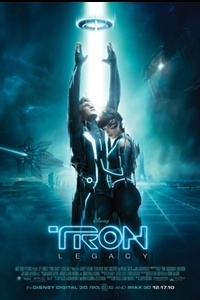
 It seems such an understatement to say, “The problem with Tron: Legacy is …” because, in all fairness, Joseph Kosinksi’s film doesn’t have a single problem. It’s got problems. Plural. The problem sectors in script and on screen gravitate towards one another, feeding off of each other’s deficiencies in some kind of perverse, parasitic relationship that results in them swelling in size until their hideous mass – this swirling, twisted orgy of character failings, action shortcomings and single-minded direction – is so big that it simply must be addressed. But even though it has a myriad of them, all of Tron: Legacy’s cinematic malignancies stem from a sole fundamental failure: The Grid is boring.
It seems such an understatement to say, “The problem with Tron: Legacy is …” because, in all fairness, Joseph Kosinksi’s film doesn’t have a single problem. It’s got problems. Plural. The problem sectors in script and on screen gravitate towards one another, feeding off of each other’s deficiencies in some kind of perverse, parasitic relationship that results in them swelling in size until their hideous mass – this swirling, twisted orgy of character failings, action shortcomings and single-minded direction – is so big that it simply must be addressed. But even though it has a myriad of them, all of Tron: Legacy’s cinematic malignancies stem from a sole fundamental failure: The Grid is boring.
That’s not to say that Tron: Legacy itself is boring. Daft Punk’s score is strong enough on its own to energize the movie, and there are pops of dazzling visuals that should snare even jaded viewers with technowizardry. But the Grid, the computer-generated fantasy world that comprises 95% of the movie, is boring. It’s the most lifeless and under-realized fantasy universe put to screen in years. Twenty-eight years to be precise, because the last time a movie’s alternate reality was this dull was when the original Tron hit theaters.
The problem with the Grid is that the creative talents behind the film want it to be one thing, while the film itself needs it to be another entirely. They want it to be a void, a limitless digital canvas of untapped potential just waiting to be exploited by the right people (and not imprisoned by programs that were created to help it be a world). What they need it to be is anything but a void. Never mind the fact that it forces you to spend most of the movie staring at an oppressive black backdrop (not even horror movies spend this much time in the dark), it simply lacks any shred of personality. For a movie with such a hard-on for meticulous design, its world is woefully under-designed.
I’ve seen a number of people complain that it is because Legacy’s pair of screenwriters didn’t understand how computers work, but that’s not the problem. The Grid is not the ’90s CGI-show reboot; it’s not a visualization of the insides of a motherboard and how a computer functions. It’s a virtual space filled with the legion of programs necessary to make a world function. So, no, the problem isn’t that the talents behind the movie don’t get computers; it’s that they don’t get society. Kosinski and company don’t understand that in order to build a compelling fantasy world, you need to stock it with the semblance of life; they need to make it appear as though there’s some kind of routine existence that happens even when our story isn’t taking place.
 What goes on in the Grid? Games. Programs fight each other to the death. Why? I have no damned clue. Is it to entertain the other programs? The ones who have already assimilated into CLU’s army? Maybe, but we don’t see that. We don’t see the programs doing anything. They don’t bet on the games. They’re not even really seen spectating the games, we just assume they’re there thanks to the roaring sound design. So what do they do when not watching the games? Do they wander the street? Do they have conversations with one another? Do they work day jobs performing whatever task they’re programmed to do? Maybe, but we don’t see that.
What goes on in the Grid? Games. Programs fight each other to the death. Why? I have no damned clue. Is it to entertain the other programs? The ones who have already assimilated into CLU’s army? Maybe, but we don’t see that. We don’t see the programs doing anything. They don’t bet on the games. They’re not even really seen spectating the games, we just assume they’re there thanks to the roaring sound design. So what do they do when not watching the games? Do they wander the street? Do they have conversations with one another? Do they work day jobs performing whatever task they’re programmed to do? Maybe, but we don’t see that.
The only semblance of personality we see in the film comes by way of the End of Line club scene, but even that’s riddled with missed opportunities. How do programs get into the seemingly private club? What do they drink? Do they get drunk and pop digital ecstasy before screwing in the bathroom? Maybe, but we don’t see any hints of that because Kosinki is apparently paranoid that if he dare let the camera wander away from Sam or Quora and actually explore the night life of the Grid, we might see something interesting.
There’s no impact given to any material other than the story of Sam. It’s as though he’s Moses and the world of the Grid parts every time he approaches so as to allow him to walk through unhindered. And if that’s the allegory you’re going for, by all means have at it, but at least make it interesting. At least allow us to imagine what life is like when Sam isn’t there.
Even if that life is a simple police state where no one is allowed to do anything, provide us with compelling evidence that we can imagine what life is like within that police state. Give us a reason to care that it even is a police state, don’t just tell us we should care with seemingly endless exposition.
 I’m not the kind of person that thinks every film should adhere to a formula that’s proven to have worked in the past, but I can’t help but imagine how much more weight would have been given to every facet of Tron: Legacy had Kosinski taken some simple cues from the carnival scene in Steven Spielberg’s A.I. Essentially the same thing happens in both: Undesirable non-humans are being rounded up for an arbitrary reason and executed publicly to the delight of an oppressing, self-appointed master race. And just when it comes time for our hero to meet a cruel fate, someone realizes he’s not like everyone else in the arena.
I’m not the kind of person that thinks every film should adhere to a formula that’s proven to have worked in the past, but I can’t help but imagine how much more weight would have been given to every facet of Tron: Legacy had Kosinski taken some simple cues from the carnival scene in Steven Spielberg’s A.I. Essentially the same thing happens in both: Undesirable non-humans are being rounded up for an arbitrary reason and executed publicly to the delight of an oppressing, self-appointed master race. And just when it comes time for our hero to meet a cruel fate, someone realizes he’s not like everyone else in the arena.
In A.I., we see all of that. We see what life is like for the non-humans. We care whether or not they’re executed. We see the kind of people that want them executed. We see the devilish joy it brings them, and we’re repulsed by it. Not in Tron: Legacy, though. No emotions are ever established. And if no emotions are ever established, why should we care about anything that happens to the denizens of the Grid? Without that kind of investment, you’ve just made a two hour-long Daft Punk music video. And while that’s awesome for Daft Punk fans, it’s a problem if you’re trying to make anything more complex than a light show.


